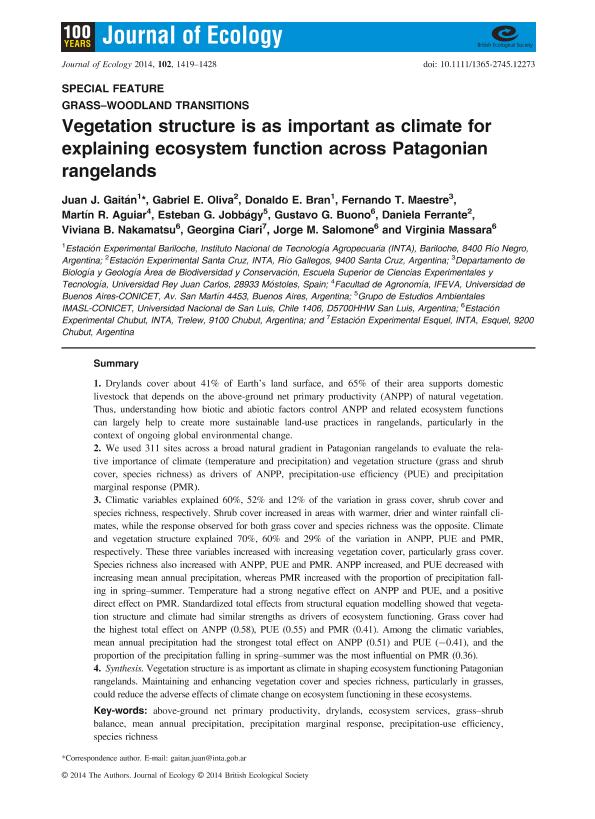Artículo
Vegetation structure is as important as climate to explain ecosystem functioning across Patagonian rangelands
Gaitan, Juan J.; Oliva, Gabriel Esteban; Bran, Donaldo E.; Maestre, Fernando T.; Aguiar, Martin Roberto ; Jobbagy Gampel, Esteban Gabriel
; Jobbagy Gampel, Esteban Gabriel ; Buono, Gustavo G.; Ferrante, Daniela; Nakamatsu, Viviana B.; Ciari, Georgina; Salomone, Jorge M.; Massara, Virginia
; Buono, Gustavo G.; Ferrante, Daniela; Nakamatsu, Viviana B.; Ciari, Georgina; Salomone, Jorge M.; Massara, Virginia
 ; Jobbagy Gampel, Esteban Gabriel
; Jobbagy Gampel, Esteban Gabriel ; Buono, Gustavo G.; Ferrante, Daniela; Nakamatsu, Viviana B.; Ciari, Georgina; Salomone, Jorge M.; Massara, Virginia
; Buono, Gustavo G.; Ferrante, Daniela; Nakamatsu, Viviana B.; Ciari, Georgina; Salomone, Jorge M.; Massara, Virginia
Fecha de publicación:
11/2014
Editorial:
Wiley
Revista:
Journal of Ecology
ISSN:
0022-0477
Idioma:
Inglés
Tipo de recurso:
Artículo publicado
Clasificación temática:
Resumen
Drylands cover about 41% of Earth's land surface, and 65% of their area supports domestic livestock that depends on the above-ground net primary productivity (ANPP) of natural vegetation. Thus, understanding how biotic and abiotic factors control ANPP and related ecosystem functions can largely help to create more sustainable land-use practices in rangelands, particularly in the context of ongoing global environmental change.
We used 311 sites across a broad natural gradient in Patagonian rangelands to evaluate the relative importance of climate (temperature and precipitation) and vegetation structure (grass and shrub cover, species richness) as drivers of ANPP, precipitation-use efficiency (PUE) and precipitation marginal response (PMR).
Climatic variables explained 60%, 52% and 12% of the variation in grass cover, shrub cover and species richness, respectively. Shrub cover increased in areas with warmer, drier and winter rainfall climates, while the response observed for both grass cover and species richness was the opposite. Climate and vegetation structure explained 70%, 60% and 29% of the variation in ANPP, PUE and PMR, respectively. These three variables increased with increasing vegetation cover, particularly grass cover. Species richness also increased with ANPP, PUE and PMR. ANPP increased, and PUE decreased with increasing mean annual precipitation, whereas PMR increased with the proportion of precipitation falling in spring–summer. Temperature had a strong negative effect on ANPP and PUE, and a positive direct effect on PMR. Standardized total effects from structural equation modelling showed that vegetation structure and climate had similar strengths as drivers of ecosystem functioning. Grass cover had the highest total effect on ANPP (0.58), PUE (0.55) and PMR (0.41). Among the climatic variables, mean annual precipitation had the strongest total effect on ANPP (0.51) and PUE (−0.41), and the proportion of the precipitation falling in spring–summer was the most influential on PMR (0.36).
Synthesis. Vegetation structure is as important as climate in shaping ecosystem functioning Patagonian rangelands. Maintaining and enhancing vegetation cover and species richness, particularly in grasses, could reduce the adverse effects of climate change on ecosystem functioning in these ecosystems.
Palabras clave:
Patagonian Steppe
,
Biogeografia
,
Estructura de La Vegetacion
,
Clima
Archivos asociados
Licencia
Identificadores
Colecciones
Articulos(IFEVA)
Articulos de INST.D/INV.FISIOLOGICAS Y ECO.VINCULADAS A L/AGRIC
Articulos de INST.D/INV.FISIOLOGICAS Y ECO.VINCULADAS A L/AGRIC
Articulos(IMASL)
Articulos de INST. DE MATEMATICA APLICADA DE SAN LUIS
Articulos de INST. DE MATEMATICA APLICADA DE SAN LUIS
Citación
Gaitan, Juan J.; Oliva, Gabriel Esteban; Bran, Donaldo E.; Maestre, Fernando T.; Aguiar, Martin Roberto; et al.; Vegetation structure is as important as climate to explain ecosystem functioning across Patagonian rangelands; Wiley; Journal of Ecology; 102; 6; 11-2014; 1419-1428
Compartir
Altmétricas



